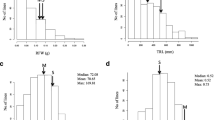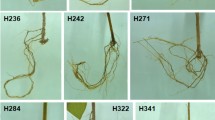Abstract
Interspecific hybrid Cucurbita rootstocks (Cucurbita maxima × Cucurbita moschata) are the most widely used rootstocks for Cucurbitaceous vegetables in the world. In recent years, scientists have focused on understanding and exploiting root architectures as new opportunities for crop improvement. Selection of parents and hybrids based on combining ability test is an effective approach in interspecific hybrid variety breeding. However, limited information is available on the combining ability tests for the rooting and graft-related traits in these rootstocks. Ondokuz Mayis University and Black Sea Agricultural Research Institute are conducting a program to breed Cucurbita rootstocks in Turkey for fifteen years. In this study, seven C. maxima (BC5F1 generation) lines as female parents and three C. moschata (S6 generation) lines as male parents were used to obtain 21 crosses. The watermelon grafted onto the interspecific hybrids and their parent rootstocks were analyzed in terms of general combining ability (GCA), specific combining ability (SCA), heritability, and heterosis for roots and graft-related traits including root volume (cm3), root length (m), root dry weight (g), hairy root rate (%), average root diameter (mm), shoot dry weight (g), graft success rate (%), and hypocotyl thickness ratio (%) by using line × tester mating design. The quotient of GCA/SCA effects for all root and hypocotyl traits were higher than 1, suggesting the preponderance of additive over non-additive gene action in the expression of these traits, whereas graft success was controlled by additive and non-additive gene effects. It was determined that average root diameter had high heritability (63.85%) and the other traits had intermediate heritability ranging from 40.59 to 58.98%. Combining ability analyses indicated that FTS5, GH12, and GRD17 lines were promising parents with greater general combining ability. Three crosses, GRD17 × FTS5, B12 × FTS5, and BH5 × CHI2 showed superior mid-parent heterosis and significant SCA for most studied characteristics. Present findings will provide significant contributions in understanding of root related characteristics and then achieving desirable improved rootstocks in C. maxima × C. moschata.


Similar content being viewed by others
References
Acquaah G (2012) Principles of plant genetics and breeding, 2nd edn. Wiley, West Sussex. https://doi.org/10.1002/9781118313718
Anido FL, Cravero V, Asprelli P, Firpo T, García SM, Cointry E (2004) Heterotic patterns in hybrids involving cultivar-groups of summer squash, Cucurbita pepo L. Euphytica 135(3):355–360. https://doi.org/10.1023/B:EUPH.0000013373.91446.f3
Ara N, Yang J, Hu Z, Zhang M (2013) Determination of heat tolerance of interspecific (Cucurbita maxima × Cucurbita moschata) inbred line of squash ‘Maxchata’ and its parents through photosynthetic response. J Agric Sci 19(3):188–197. https://doi.org/10.1501/Tarimbil_0000001244
Baker RJ (1978) Issues in diallel analysis. Crop Sci 18:533–536. https://doi.org/10.2135/cropsci1978.0011183X001800040001x
Bertucci MB, Suchoff DH, Jennings KM, Monks DW, Gunter CC, Schultheis JR, Louws FJ (2018) Comparison of root system morphology of cucurbit rootstocks for use in watermelon grafting. HortTechnology 28(5):629–636. https://doi.org/10.21273/HORTTECH04098-18
Bie Z, Nawaz MA, Huang Y, Lee JM, Colla G (2017) Introduction of vegetable grafting. In: Colla G, Pérez-Alfocea F, Schwarz D (eds) Vegetable grafting: principles and practices. CABI Publishing, Wallingford, pp 1–21
Cerutti PH, Grigolo S, Melo RC, Fioreze ACCL, Guidolin AF, Coimbra JLM (2020) Combining ability between common bean gene groups for root distribution trait. Ciênc Agrotec 44:e011520. https://doi.org/10.1590/1413-7054202044011520
Darrudi R, Nazeri V, Soltani F, Shokrpour M, Ercolano MR (2018) Evaluation of combining ability in Cucurbita pepo L. and Cucurbita moschata Duchesne accessions for fruit and seed quantitative traits. J Appl Res Med Aromat Plants 9:70–77. https://doi.org/10.1016/j.jarmap.2018.02.006
Davis AR, Perkins-Veazie P, Sakata Y, Lopez-Galarza S, Maroto JV, Lee SG, Huh YC, Sun Z, Miguel A, King SR, Cohen R, Lee JM (2008) Cucurbit grafting. CRC Crit Rev Plant Sci 27(1):50–74. https://doi.org/10.1080/07352680802053940
Dehdar B, Amiri S, Panahi B, Mohammadi R (2020) Combining ability analysis of tuber yield and related traits in potatoes. Genetika 52(1):215–228. https://doi.org/10.2298/GENSR2001215D
Devi P, Lukas S, Miles C (2020) Advances in watermelon grafting to increase efficiency and automation. Horticulturae 6(4):1–13. https://doi.org/10.3390/horticulturae6040088
Edelstein M, Cohen R, Gur A, Elkabetz M, Pivonia S, Grosch R, Forster P, Schwarz D (2017) Performance of interspecific Cucurbita rootstocks compared to their parental lines. Sci Hortic 216:45–50. https://doi.org/10.1016/j.scienta.2016.12.031
Falconer DS (1989) Introduction to quantitative genetics, 3rd edn. Longman Scientific & Technical, Essex, England and John Wiley & Sons, Inc., New York
Fellahi ZEA, Hannachi A, Bouzerzour H, Boutekrabt A (2013) Line× tester mating design analysis for grain yield and yield related traits in bread wheat (Triticum aestivum L.). Int J Agron 2013:1–9. https://doi.org/10.1155/2013/201851
Feyzian E, Dehghani H, Rezai AM, Javaran MJ (2009) Diallel cross analysis for maturity and yield-related traits in melon (Cucumis melo L.). Euphytica 168(2):215–223. https://doi.org/10.1007/s10681-009-9904-9
Fita A, Picó B, Nuez F (2006) Implications of the genetics of root structure in melon breeding. J Am Soc Hortic Sci 131(3):372–379. https://doi.org/10.21273/JASHS.131.3.372
Gregory PJ (2006) Plant roots: growth, activity and interaction with soils. Blackwell Publishing, Oxford
Hassell RL, Memmott F, Liere DG (2008) Grafting methods for watermelon production. HortScience 43(6):1677–1679. https://doi.org/10.21273/HORTSCI.43.6.1677
Hayase H (1950) Cucurbita-crosses, I. The pollen tube growth in interspecific crosses. J Jour Genetic 25:181–190
Kagimbo F, Shimelis H, Sibiya J (2019) Combining ability, gene action and heritability of weevil resistance, storage root yield and yield related-traits in sweetpotato. Euphytica 215(13):1–17. https://doi.org/10.1007/s10681-019-2338-0
Kanagarasu S, Nallathambi G, Ganesan KN (2010) Combining ability analysis for yield and its component traits in maize (Zea mays L.). Electron J Plant Breed 1(4):915–920
Kanda T (1984) Squash. In: Shinohara S (ed) Vegetable seed production technology of japan elucidated with respective variety development histories, particulars Shinohara’s authorized. Agr. Consult. Engineer Office, Nishiooi, pp 395–426
Karaağaç O (2013) Determination of rootstock potential of winter squash (C. maxima Duchesne) and pumpkin (C. moschata Duchesne) genotypes selected from Black Sea Region for watermelon. Doctoral dissertation, Ondokuz Mayis University, Samsun, Turkey, p 256 (in Turkish)
Karaağaç O, Balkaya A (2013) Interspecific hybridization and hybrid seed yield of winter squash (Cucurbita maxima Duch.) and pumpkin (Cucurbita moschata Duch.) lines for rootstock breeding. Sci Hortic 149:9–12. https://doi.org/10.1016/j.scienta.2012.10.021
Karaağaç O, Balkaya A, Göçmen M, Şimşek İ, Kandemir D (2018) Use of phenotypic selection and hypocotyl properties as predictive selection criteria in pumpkin (Cucurbita moschata Duch.) rootstock lines used for grafted cucumber (Cucumis sativus L.) seedling cultivation. Turk J Agric for 42(2):124–135. https://doi.org/10.3906/tar-1709-52
Karaağaç O (2020) Hybrid Cucurbita rootstocks improve root architecture, yield, quality, and antioxidant defense systems of cucumber (Cucumis sativus) under low temperature conditions. Int J Agric Biol 23(3):613–622. https://doi.org/10.17957/IJAB/15.1331
Katuuramu DN, Wechter WP, Washington ML, Horry M, Cutulle MA, Jarret RL, Levi A (2020) Phenotypic diversity for root traits and identification of superior germplasm for root breeding in watermelon. HortScience 55(8):1272–1279. https://doi.org/10.21273/HORTSCI15093-20
Kempthorne O (1957) An introduction to genetic statistics. Wiley, New York
Kenga R, Alabi SO, Gupta SC (2004) Combining ability studies in tropical sorghum (Sorghum bicolor (L.) Moench). Field Crops Res 88(2–3):251–260. https://doi.org/10.1016/j.fcr.2004.01.002
King SR, Davis AR, Zhang X, Crosby K (2010) Genetics, breeding and selection of rootstocks for Solanaceae and Cucurbitaceae. Sci Hort 127:106–111. https://doi.org/10.1016/j.scienta.2010.08.001
Kong Q, Chen J, Liu Y, Ma Y, Liu P, Wu S, Huang Y, Bie Z (2014) Genetic diversity of Cucurbita rootstock germplasm as assessed using simple sequence repeat markers. Sci Hort 175:150–155. https://doi.org/10.1016/j.scienta.2014.06.009
Korakot N, Yang J, Zhang M, Ye F, Lin Y (2010) A novel inbred squash line developed from interspecific crosses between Cucurbita maxima and Cucurbita moschata. In: Thies J, Levi A, Kousik S (eds) Proceeding Cucurbitaceae 2010. 14–18 November, Charleston, South Carolina, USA, pp 129–131
Korzeniewska A, Niemirowicz-Szczytt K (1993) Combining ability and heterosis effect in winter squash (Cucurbita maxima Duch.). Genet Pol 34(3):259–272
Musembi KB, Githiri SM, Yencho GC, Sibiya J (2015) Combining ability and heterosis for yield and drought tolerance traits under managed drought stress in sweetpotato. Euphytica 201(3):423–440. https://doi.org/10.1007/s10681-014-1230-1
Pandiarana N, Chattopadhyay A, Seth T, Shende VD, Dutta S, Hazra P (2015) Heterobeltiosis, potence ratio and genetic control of processing quality and disease severity traits in tomato. N Z J Crop Hortic Sci 43(4):282–293. https://doi.org/10.1080/01140671.2015.1083039
Picó B, Thompson AJ, Gisbert C, Yetişir H, Bebeli PJ, Colla G (2017) Genetic resources for rootstock breeding. In: Colla G, Pérez-Alfocea F, Schwarz D (eds) Vegetable grafting: principles and practices. CABI Publishing, Wallingford, pp 22–69
Robinson HF, Comstock RE, Harvey PH (1949) Estimates of heritability and the degree of dominance in corn. J Agron 41(8):353–359. https://doi.org/10.2134/agronj1949.00021962004100080005x
Rukundo P, Shimelis H, Laing M, Gahakwa D (2017) Combining ability, maternal effects, and heritability of drought tolerance, yield and yield components in sweetpotato. Front Plant Sci 7(1981):1–14. https://doi.org/10.3389/fpls.2016.01981
Saleh GB, Gritton ET (1988) Genetic control of root weight, root volume and root to shoot weight ratio in peas. Pertanika 11(2):165–173
Sharma HC, Dhillon MK, Pampapathy G, Reddy BVS (2007) Inheritance of resistance to spotted stem borer, Chilo partellus, in sorghum, Sorghum bicolor. Euphytica 156(1):117–128. https://doi.org/10.1007/s10681-007-9358-x
Sharma RC, Smith EL, McNew RW (1991) Combining ability analysis for harvest index in winter wheat. Euphytica 55(3):229–234. https://doi.org/10.1007/BF00021243
Shashikumar KT, Pitchaimuthu M, Kumar DP, Rawal RD (2011) Heterosis and combining ability for resistance to powdery mildew in adult melon plants. Plant Breed 130(3):383–387. https://doi.org/10.1111/j.1439-0523.2010.01798.x
Sheshshayee MS, Abou-Kheir E, Rohini S, Srivastava N, Mohanraju B, Nataraja KN, Prasad TG, Dayakumar M (2011) Phenotyping for root traits and their improvement through biotechnological approaches for sustaining crop productivity. In: Varshney R (ed) Costa de Oliveira A Root genomics. Springer, Berlin, pp 205–232
Singh RK, Chaudhary BD (1985) Biometrical methods in quantitative genetic analysis. Kalyani Publishers, New Delhi
Su J, Zhang F, Yang X, Feng Y, Yang X, Wu Y, Guan Z, Fang F, Chen F (2017) Combining ability, heterosis, genetic distance and their intercorrelations for waterlogging tolerance traits in chrysanthemum. Euphytica 213(42):1–15. https://doi.org/10.1007/s10681-017-1837-0
Suchoff DH, Gunter CC, Louws FJ (2017) Comparative analysis of root system morphology in tomato rootstocks. HortTech 27(3):319–324. https://doi.org/10.21273/HORTTECH03654-17
Tajima R, Kato Y (2013) A quick method to estimate root length in each diameter class using freeware image. J Plant Prod Sci 16(1):9–11. https://doi.org/10.1626/pps.16.9
Tamilselvi NA, Jansirani P, Pugalendhi L (2015) Estimation of heterosis and combining ability for earliness and yield characters in pumpkin (Cucurbita moschata Duch. Ex. Poir.). Afr J Agric Res 10(16):1904–1912. https://doi.org/10.5897/AJAR2014.9099
Thompson AJ, Picó B, Yetişir H, Cohen R, Bebeli PJ (2017) Rootstock breeding: current practices and future technologies. In: Colla G, Pérez-Alfocea F, Schwarz D (eds) Vegetable grafting: principles and practices. CABI Publishing, Wallingford, pp 70–93
Traka-Mavrona E, Koutsika-Sotiriou M, Pritsa T (2000) Response of squash (Cucurbita spp.) as rootstock for melon (Cucumis melo L.). Sci Hort 83(3–4):353–362. https://doi.org/10.1016/S0304-4238(99)00088-6
Uretsky J, Loy JB (2017) Evaluation of morphological traits associated with productivity in F1 interspecific (Cucurbita maxima Duch x C. moschata Duch) hybrid processing squash. HortScience 52(9):1156–1163
Wachsman G, Sparks EE, Benfey PN (2015) Genes and networks regulating root anatomy and architecture. New Phytol 208(1):26–38. https://doi.org/10.1111/nph.13469
Whitaker TW (1933) Cytological and phylogenetic studies in the Cucurbitaceae. Bot Gaz 94(4):780–790
Ye H, Roorkiwal M, Valliyodan B, Zhou L, Chen P, Varshney RK, Nguyen HT (2018) Genetic diversity of root system architecture in response to drought stress in grain legumes. J Exp Bot 69(13):3267–3277. https://doi.org/10.1093/jxb/ery082
Zhang QI, Yu E, Medina A (2012) Development of advanced interspecific-bridge lines among Cucurbita pepo, C. maxima, and C. moschata. HortScience 47(4):452–458. https://doi.org/10.21273/HORTSCI.47.4.452
Acknowledgements
This research was supported by Ondokuz Mayis University and Republic of Turkey Ministry of Agriculture and Forestry. The author is grateful to Prof. Dr. Ahmet Balkaya (Ondokuz Mayis University of Samsun, Turkey) for helpful discussions during preparation of the manuscript.
Funding
This research was partly financed by the project PYO.ZRT.1901.09.015 from the Ondokuz Mayis University.
Author information
Authors and Affiliations
Corresponding author
Ethics declarations
Conflict of interest
The author declares no conflict of interest.
Additional information
Publisher's Note
Springer Nature remains neutral with regard to jurisdictional claims in published maps and institutional affiliations.
Rights and permissions
About this article
Cite this article
Karaağaç, O. Combining ability and heterosis for root structure and graft-related traits of interspecific Cucurbita rootstocks. Euphytica 217, 166 (2021). https://doi.org/10.1007/s10681-021-02884-y
Received:
Accepted:
Published:
DOI: https://doi.org/10.1007/s10681-021-02884-y




